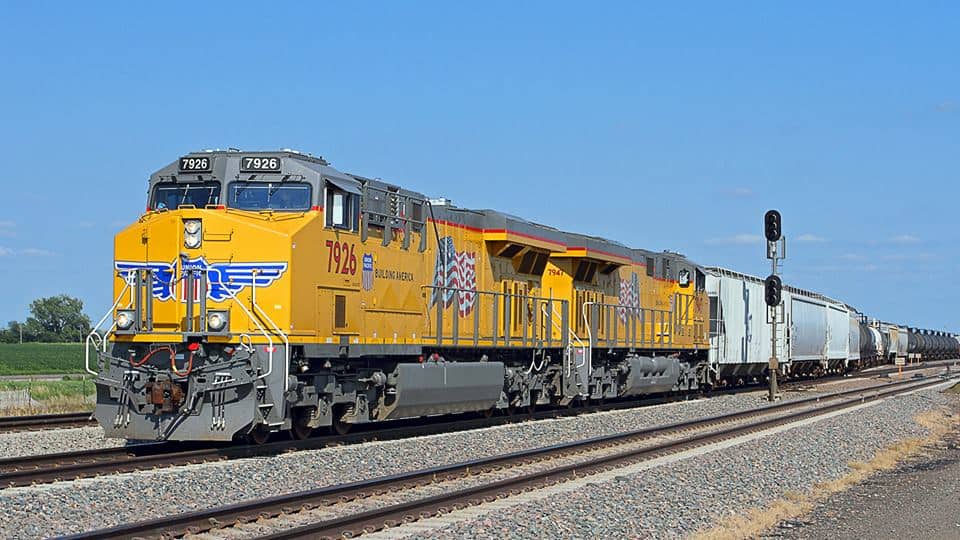Image credit: Union Pacific/Facebook
Union Pacific’s (NYSE: UNP) first quarter net profit rose 6 percent amid company efforts to rationalize or reorganize existing assets to streamline operations under precision scheduled railroading (PSR).
First quarter 2019 net income increased 6 percent to $1.39 billion, or $1.93 per diluted share, compared with $1.31 billion, or $1.68 per diluted share in the first quarter of 2018.
Meanwhile, revenue in the first quarter of 2019 fell 2 percent to $5.4 billion as freight revenues also declined by 2 percent. UP attributed the freight revenue decline to lower volumes for energy and agricultural products, which were partially offset by higher volumes for industrial and premium products.
The company’s operating ratio in the first quarter of 2019 was 63.6 percent, which UNP said was a 1 percent improvement from the first quarter of 2018. Freight car velocity also improved 7 percent to 185 daily miles per car.

Average train speed and terminal dwell time also fell in the first quarter of this year compared with the first quarter of 2018. Average train speed was down to 23.3 miles per hour, compared with a better speed of 24.8 miles per hour in the first quarter of 2018. However, terminal dwell time (the amount of time a railcar is idle in a railyard) was down significantly, averaging 26.6 hours, compared with 33 hours in the first quarter of 2018.
The lower operating ratio comes as UP began its transition last year to PSR, an operating tool in which railroads schedule railcars on a fixed schedule regardless of how full the carloads are. UP is one of four Class I railroads that has adopted the model in recent years.
UP officials acknowledged that PSR is helping the railroad recover from record flooding that occurred in the Midwest in March. UP is still experiencing delays as repairs continue on rail lines in Iowa, Kansas and Nebraska, and the company has said it is currently watching water levels around St. Paul, Minnesota. Information on the latest service updates can be found here.
“We delivered record first quarter financial results driven by improved operating performance, while dealing with significant weather challenges,” said UP president and chief executive officer Lance Fritz. UP’s operating plan, which incorporates PSR principles, “created a more resilient and robust network, allowing us to quickly return to normal operations.”
Despite flooding and severe winter weather adversely affected volumes and operational costs, UP was still able to obtain a lower operating ratio, company officials said. (A lower operating ratio is preferable to a higher ratio.)
UP details progress on initial roll-out of PSR
Since a goal of PSR is to reduce the number of times a railcar gets “touched” or handled in its journey along the network, UP has implemented efforts to lengthen trains and cut down on assets as a way to streamline operations.
“There’s still a lot of opportunity ahead of us to improve asset utilization and network efficiency,” said UP chief operating officer Jim Vena, a veteran of Canadian National (NYSE: CNI) who is spearheading efforts to transition to PSR. CN has been utilizing PSR for years.
Union Pacific has stored 1,900 locomotives as of March 31 while also running longer trains. It has also stopped humping railcars at its Hinkle yard in Oregon and its Pine Bluff yard in Arkansas. Humping cars is a sorting method used to organize cars according to their destination.
“The terminal is a subset of what we do. We don’t look at shutting down hump yards. We look at how do we speed up railcars,” Vena said.
UP is considering potentially rationalizing or reorganizing additional terminals and assets, such as its multiple intermodal facilities in the Chicago area. The company also decided to “pause construction” and reallocate 2019’s capital funding designated for the Brazos, Texas yard to create siding extensions on its Sunset corridor, which connects El Paso, Texas to Los Angeles. Funding previously designated for the Brazos yard will also go to enabling Santa Teresa’s yard to split and combine trains so that longer trains can run on the Sunset corridor.
UP is still determining the fate of the Brazos yard, a proposed $550 million high-capacity classification yard.
“If the business is such that you need it, it would be remiss to start fooling around and moving cars to other places,” Vena said. “My focus is, you take the touch points out. You go to longer trains. You have trains that can handle more cars. And if we need a hump yard, then we put it in place.”











One Comment
Comments are closed.